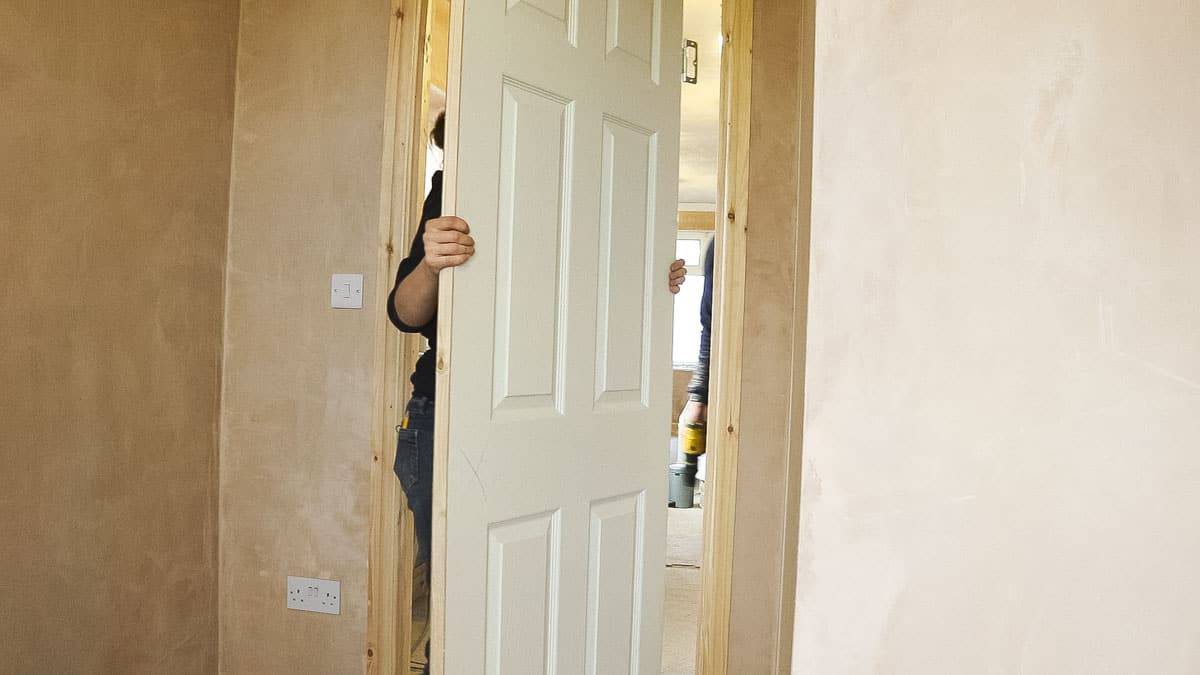Tutorial on Door Installation
In straightforward fashion, this article will explain how to hang a door. It will show you step-by-step how to install an interior door and what you’ll need to complete it successfully.

DIY Guide: Door Installation
Detailed instructions for installing a door are provided below. Make sure you have a clean, well-lit area to work in, all the necessary materials, and safety gear before beginning. A few helpful checklists will be provided after you’ve completed these measures.
Step 1: Measure height and width
Get a tape measure first, so you know what size door you need to build. Start by gauging the width of the room and working your way up to the height of the doorframe.

You should measure the width of the frame at three different points: the bottom, the middle, and the bottom. Take careful notice of these dimensions.
Step 2: Drawing line
The next step is to check that your door is hanging properly. The door’s edges should have directional arrows printed on them to help you find your way.

An arrow indicating the side on which the handle is to be mounted. If there is no obvious arrow pointing in this direction, you can simply draw one.
Step 3: Check doorframe level
The doorframe must now be checked for squareness and plumbness. To achieve this, prop up the vertical part of the doorframe with your spirit level.

If you have a spirit level, make sure the bubble sits in the middle of the two lines. Check that the corner of the frame is square by holding up a set square to it. Each top corner, ideally, will have a snug fit.
Step 4: Cutting door height
Next, you’ll want to transfer your dimensions to your door so you can start planning it down to size. Mark the bottom right and left sides of the door after taking a height measurement from the top down.

Now, using the pencil and the metal rule, draw a straight line across to use as a benchmark for determining the final door height.
Step 5: Using a Circular Saw
Now, adjust your circular saw so that its teeth are parallel to the line you drew. Reduce the length along the bottom with a saw. Then, use a piece of sandpaper to buff the raw edge.

Step 6: Draw height measurements
The next step is to transfer the width measurement to the door. First, measure the height, width, and depth of the door, and then use those markings to draw a straight line along the length of the door. This is the next step in the door trimming instructions.

Step 7: Using sandpaper
Run your electric plane along the edge of your door to trim the surplus up to the line of demarcation. You’ll need to push down firmly on the plane in order to cut a clean, even slice off the door. It’s possible that you’ll need to use sandpaper to finish the cut.

Step 8: Correctly sized gap
The next procedure requires some dexterity; an extra set of hands may be helpful. To properly align the door in the frame, you may also require two penny pieces and wedges. A two-pence coin’s width is the recommended gap on the door’s outside edges.

So, you can employ the coins to ensure a consistent and appropriate space between objects. Use your wedges and move them around until you find a comfortable position for the door.
Step 9: Hinge position marking
You’ve successfully positioned the door where you want it to be. The proper placement of the hinges can be indicated. Where your original door hinges were attached to the doorframe, there should be three notches.

Make a note of these on your new door’s face so you can install the hinges correctly. The bottom of each hinge should have a single mark made on it.
Take the door off its hinges. Align the bottom of one of your door hinges with the first mark. Mark the width and depth of the hinge on the door by drawing a ring around it. Put in a similar screw into the other two hinges.
Step 10: Indents for hinges
To make the holes for the hinges, you’ll need a wooden mallet and some sharp wood chisels. Mark the door where the hinges will go with a chisel that is the right size for the job.

Light taps inside the pencil line to form a thin groove are recommended. The next step is to use a chisel to remove the wood from within the chiselled lines.
If you try to remove too much wood at once, it could crack. When removing wood with a chisel, it is advisable to tap it down at 4- to 6-millimeter intervals before utilising the flat edge.
Now that you’ve chiselled away enough material, you may test whether or not the hinges will fit in the resulting openings. While the hinges are in place, use a pencil to make a mark at the location of each screw hole.
Step 11: Holes for the hinges
Use a pilot bit in an electric drill to create holes where the hinge screws will go, following your pencil markings. The diameter of the drill bit should be less than that of the screws. The electric screwdriver will make short work of attaching the hinges to the door.

Step 12: Securing hinges
Placing the door in the frame is the next step. You’ll need the wedges again, or another person, to accomplish this.

Align the door’s hinges with the notches on the frame. Use your electric screwdriver to loosely secure the door to the frame by inserting a screw into the centre hole of each hinge.
Carefully try opening and closing the door to ensure a good fit. You can fasten the door to the frame with the remaining screws if you’re satisfied.
Step 13: Fitting hinges
Now you may install the door’s latch and handles and make the door easy to open and close. The solution is to outline the edge of your door with guides.

Using your set square, draw a straight line down the perimeter of the door, then use your pencil to mark the centre of the striking plate. Mark the middle of the door’s edge using your tape measure here.
The next step is to use a flat drill bit that is slightly larger than your latch; a 22mm bit is typically suitable. If you want to drill a hole exactly the same depth as your latch, wrap a piece of masking tape around the drill bit’s arm.
Use this as a measuring tool to determine how deep into the door edge you need to drill. While the wedges are keeping the door propped open, drill through the edge of the door at the middle mark.
Step 14: Linening latch
Place the striking plate of your latch over the opening, then make a pencil outline of the plate. Remove the wood inside the line you just drew with your chisels until you reach the depth of your striking plate.

To repeat, make a groove inside the lines by tapping your chisel inside them, and then use the flat edge to carve away the board. Make sure the striking plate is flush with the door’s edge now.
Drill the screw pilot holes while it’s in position. Use a countersink bit to create holes for the screws, as they must also sit flush with the door.
Step 15: Creating holes for the latch
The next step is to drill a hole for the latch bar of your handle. Holding the latch at the proper height, mark the exterior of the door with a pencil to indicate where the hole for the bar will be drilled.

Find a flat drill bit that will do the job. The standard size is 13mm. Put this to work cutting a hole in your door. Drilling through only one side of a door might cause the veneer to crack or split, therefore it’s best to drill through from both sides.
You can now screw in your latch mechanism after popping it into place. The next step is to insert the latch bar through the newly created opening.
Step 16: Attach the handles
The last step is to fasten the grips. Pull the latch bar back and slide the first handle over it to close the door. Check the levelness of the handle plate with a spirit level now. Drill the pilot holes for the screws while firmly grasping the grip to prevent the drill from slipping.

To adjust the handle on the opposite side of the door, simply repeat the previous steps. Just make sure everything is working by giving the door a quick test before you leave.
Door Installation Tools

Here is a full list of everything you will need to hang a door:
- Circular saw or handsaw
- Clamps to hold your door in place whilst cutting to size
- Electric drill
- Electric plane
- Pencil
- Sandpaper that’s suitable for use on wood
- Screwdriver
- Set of drill bits, including flat bits
- Set of sharp wood chisels
- Set square
- Spirit level: one small and one long level
- Tape measure
- Wooden mallet
Safety Equipment for Hanging a Door
When you do things on your own, you should always have the right safety gear. Dust and other tiny things can hurt your eyes. Power tools can also hurt your ears with their noise.

- Dust mask
- Ear defenders or plugs
- Protective work gloves
- Safety goggles
Materials You Need to Hang a New Door
These are the most important things you’ll need to hang your new door. There are a few things that will make hanging the door easier, some of which are pretty clear:
- Your choice of internal door
- Door handles
- Fixings (latch bar and screws)
- Latch mechanism
- Masking tape to create a guideline on your drill bit
- Three-door hinges
- Two-penny coins to help you position the door
- Wood or plastic wedges for holding the door in position when fitting
Putting in a door isn’t hard, but you will need to clear off some room. It’s important to have enough space to move about while working without having to worry about knocking over any furniture. Ample clearance on either side of the entryway is recommended.
Steps to Take Before Installing a Door
Even though putting in a door isn’t hard, you’ll need to make some room first. Make sure you have enough space to work without running into things or bumping into furniture. You should leave some room on both sides of the opening.

You’ll also need room to work on the door while it’s not in the frame. This could happen inside or outside. You might want to work near the door so that you don’t have to take the door back, or you might want to work outside so that there is less sawdust in the house.
A good way to get some air flow while cutting and sanding is to open windows if you’re working inside.
If you want to take off an old door, you’ll need to make this loose first. Don’t lose any of the door furniture pieces if you’re going to use them again. Keep this somewhere safe.
When the door is off the frame, you can easily clean or paint the frame. But make sure you give the paint plenty of time to dry before you hang the new door.
If you want to hang your new door, make sure you have all the tools and supplies you need first. Not having enough of something is not what you want to find out halfway through the job. For this, you can use the lists.
You should give your new wood door some time to get used to the room. The best thing to do is leave it flat in the room where it will stay for about a week.
Door Maintenance
Doors get a lot of use because they are often in places that get a lot of use. That being said, some upkeep could help your door stay in good shape.
If you take good care of the surface of wooden doors or doors with a wood finish, they will stay in good shape. Putting varnish, colour, oil, or paint on them again and again will help them stay in good shape.

The surface will last longer if you keep the doors and knobs clean. They will also look good. What kind of cleaner to use should be based on what the maker says. But a dustpan and wood polish should be able to clean doors that are painted or varnished. You can clean painted doors with a wet cloth and a mild cleaner, like dish soap.
A window cleaner or warm water and vinegar can be used to clean glazed doors. Use a clean cloth to buff them dry. Handles are made of different materials, so you should clean them with an industrial cleaner that is made for that kind of material and then wax them with the right kind of wax for metal.
If the door is hard to open and close, oil the hinges and latches. This will keep the moving parts from getting damaged and keep you from using too much force, which could damage the door.
Finally, the door may not be the only thing that needs to be fixed. The frame and walls around the door may also need it. Vacuum or dust your frame often, making sure to get around the hinges and latch holes to keep them from getting clogged with dirt and dust. To keep door handles from damaging walls, use a set or moveable doortop.
How To Remove Old Door
In order to install a new interior door, it may be necessary to remove the old one first. Plus, there’s a quick and easy technique to remove doors without risking injury.

A few basic tools will be required initially. Acquire a flat-head screwdriver, hammer, and nail. Gather your implements and position yourself inside the room to which your door opens.
Now shut the door all the way. You ought to notice that your door’s hinge mechanisms protrude from the frame. To remove the door, you must remove the three hinge pins that run through each hinge.
Your hinge pins may be securely fastened in a number of ways; however, the simplest method involves holding a nail upside down at the base of the hinge and gently tapping the nail upwards with the hammer to remove the pin.
You can use a screwdriver to pry the pin up after it has moved a few millimetres, or you can use your hand to pull it out if it’s loose enough.
It should be possible to remove the door from the frame after removing all three pins. To begin, use the door handle to gently pry it open. After that, with the door’s weight on top, carefully lower it towards you until it lies flat. If you need assistance, it’s better to ask for it.
To remove the remaining hinges from the doorframe, you’ll need the appropriate screwdriver.
FAQs
Which paint is ideal for interior doors?
The options for painting wooden doors include satin, gloss, or eggshell. Which one you use is a matter of taste. Gloss paint is more durable than flat paint and has a high shine, although it can take longer to cure.
Satin paint has a lower gloss and is long-lasting; also, certain satin paint products are washable. Eggshell’s matte sheen is at home in many contemporary interior design schemes, but it also makes it more susceptible to wear and tear. Depending on the colour you use, priming the wood before painting may be necessary.
How much does the installation of a new door typically cost?
The average cost to hang a door is around £70. Supply and installation costs for common interior doors, including flush and panel doors, range from £70 to £800.
Having the door custom-sized and fitted with latches, however, could increase the final price. Additional costs may be incurred for painting or repairing the framework. The cost of a door may also vary depending on its construction material. A solid oak door will be more expensive than a hollow core laminated or moulded door.
What are the typical dimensions for an inside door?
As a result, door sizes and doorframe dimensions vary widely around the United Kingdom. Internal doors, on the other hand, typically only come in four standard sizes, with edges that can be trimmed or planed to fit any door frame.
Although 1981mm x 762mm x 35mm doors fit into most standard door frames, newer homes typically feature bigger doors to accommodate wheelchairs.
What is the finest door material?
The standard for inside doors has always been hardwood. It’s easy to paint, stain, or varnish to your liking, plus it adds personality and helps keep out draughts.
However, moulded MDF and hollow core doors might be cheaper and easier to install and handle due to their reduced weight. A glazed door could also be a suitable choice if natural light is scarce in your home or room. The door must have glass installed that complies with the British Safety Standard, nevertheless.
How about a door handle?
If the mechanism is malfunctioning or you just want a new look, you can swap out the door handle by removing the plate from the door.
If you decide to switch handle types, you may need to use wood filler to cover up any holes or scars left by the old handle plate before painting.









